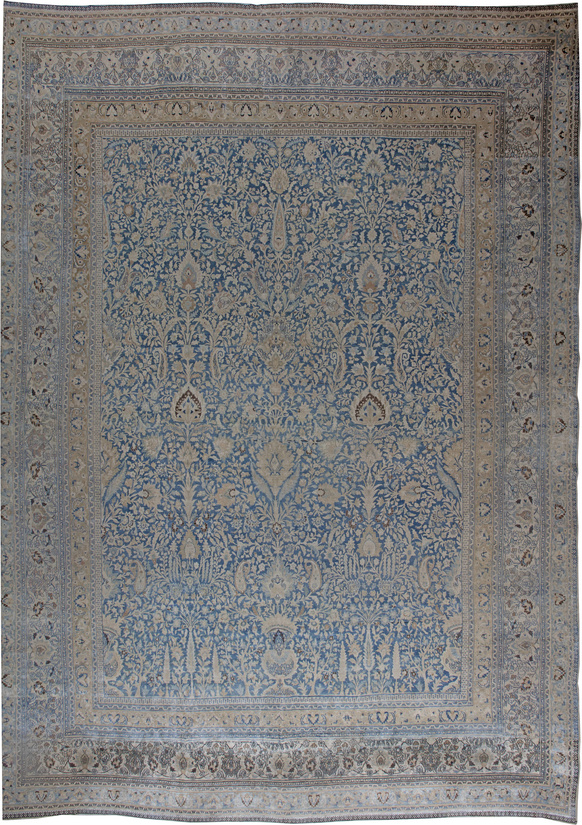In the course of her research into classical oriental carpets, the author has identified a family of early Persian wool pile carpets linked by particular field motifs and border designs, as well as by shared structural and chromatic qualities. In this article she defines the features that allow us to consider them a discrete group, and presents the evidence for assigning them an east Persian provenance and dating them to the 17th and 18th centuries.
Carpets in what I will call the East Persian ‘shrub’ group combine, in a thoroughly original synthesis, a range of distinctive features otherwise thought to be typical of different classical Persian carpet genres. Some show a basic design concept related to that of the Kerman ‘vase’ carpet type, in others the link is to the so-called ‘Herat’ or ‘Indo-Esfahan’ spiral-tendril type, while parallels with Indian carpets can be discerned in many cases. Constantly recurring field motifs include flowering shrubs and rounded palmettes with curved petals and trefoil finials. Scattered small S-shaped leaf forms are also common. The preferred main border consists of alternating cypresses and palmettes. A minor border with a simple vine meander from which small flowers and leaves depend often occurs. The corners of the borders are always perfectly resolved.

Most ‘shrub’ carpets have an elongated format and an all-cotton foundation, with depressed Z4S warps and three weft shoots. The asymmetrically knotted pile is open to the left, and some examples have jufti knots, usually in conjunction with normal two-warp knots. Density varies between about 1.800 and 3.000 knots per square decimetre. In terms of palette, a distinctive shade of orange is often used in field and/or border.
Surviving examples of this family of ‘shrub’ carpets can be divided and subdivided into six groups and additional sub-groups according to their field designs.
Type 1 has four subdivisions. The first, type 1A, are the ‘shrub-vase’ carpets. Their complex field pattern consists of an ascending repeat in horizontal rows on a dark green ground. The rows contain vases from which jut flower stems that alternate – offset diagonally from row to row – with bulbous forked-leaf forms from which sprout flowering shrubs. A closely related variant, type 1B, are the ‘shrub-tree’ carpets. It has somewhat different motifs in the rows in its field. Although the bulbous forked-leaf forms are very similar to those in type 1A, there are pointed trees between them instead of vases. Type 1C is a transitional design, showing rows of shrubs and individual vases. Individual flowering shrubs, drawn in a relatively naturalistic manner, are aligned in mirror-image symmetry around the longitudinal axis. The design of Type 1D, with rows of shrubs, show an affinity to Indian carpets. A red-grounded carpet with a central medallion, has flowering shrubs inserted within and between curved forked-leaf surrounds similar to the bulbous forked-leaf forms of type 1A. There are no vases; instead each shrub rises from a bowl-like form.
Type 2, the ‘shrub-niche’ carpets includes a pair of fragmented red-ground jufti-knotted carpets with rows of broad niches. These have shrubs in every second niche, which has and orange ground, and between the niches.
Among the ‘shrub-vine’ carpets, type 3A, are four very long red-ground carpets and a fragment, with features of both ‘shrub’ carpets and spiral-tendril carpets of the so-called ‘Herat’ group. A relationship to the ‘Herat’ spiral-tendril carpets is evident in the ground colors of both field and border, and in the flowers and cloudbands on vines in the field. Type 3B comprises ‘vine carpets with medallions’. The few extant red-ground carpets in the ‘Herat’ style with superimposed medallions all show a relationship with ‘shrub’ carpets. They all contain a great deal of orange.
Red-ground ‘shrub carpets with arabesque medallions’ are type 4. Quatrefoil medallions, formed from pairs of forked leaves, are the dominant motifs, and they have cypress and palmette borders as well as typical secondary stripes.
Type 5 ‘shrub-arabesque’ fragment has a cypress and palmette border on an orange ground, plus typical minor borders with a simple vine meander. Its field displays a further design type, with a white ground and spiralling tendrils ending in elegant forked leaves.
In type 6, the jufti-knotted ‘shrub-lattice’ carpets, a flowering shrub is set within each small individual compartment in a star-, or more rarely, diamond-lattice.
In summary, our ‘shrub’ carpets are associated with Kerman ‘vase’ carpets through their depiction of vases, flowering shrubs and use of ascending patterns – both individual and within a lattice – as well as through their cypress borders.
Most ‘shrub’ carpets can be dated to the 17th century by association with ‘vase’ carpets and spiral-tendril carpets.
Source: Christine Klose in HALI – Carpet, Textile and Islamic Art, issue 125.

